
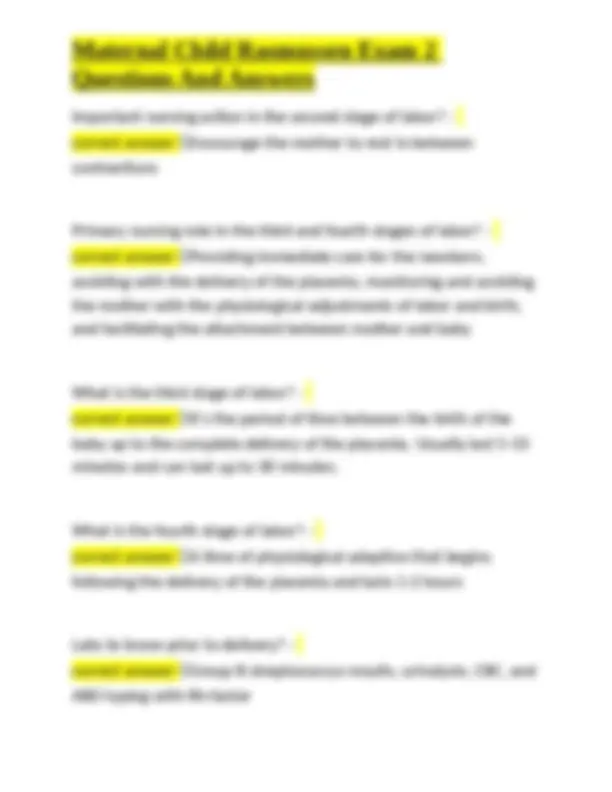
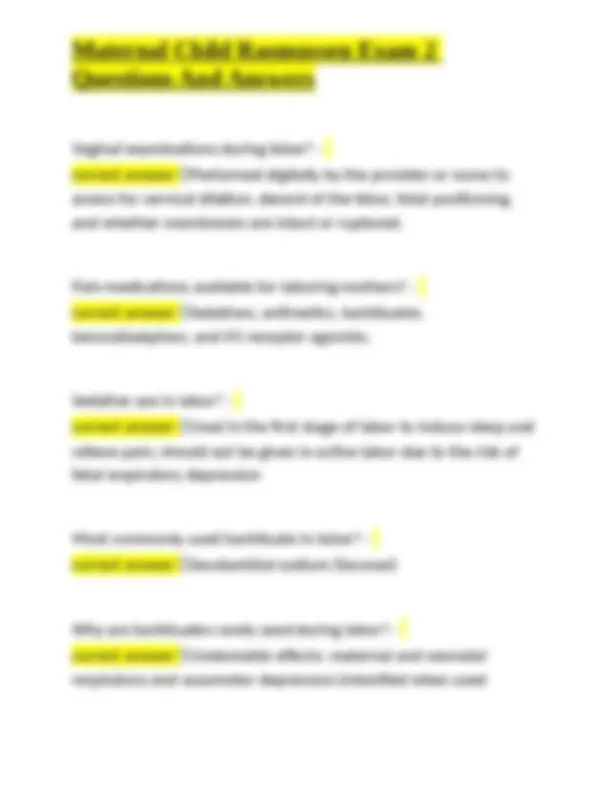
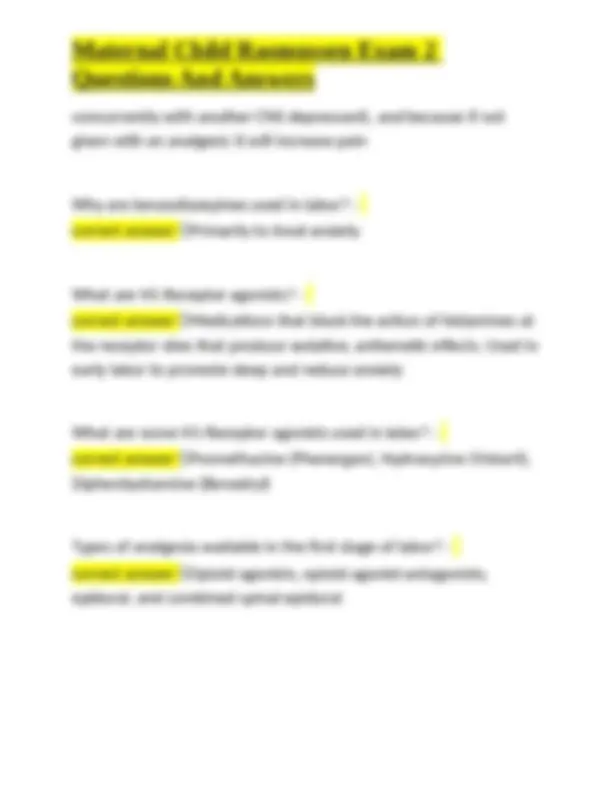
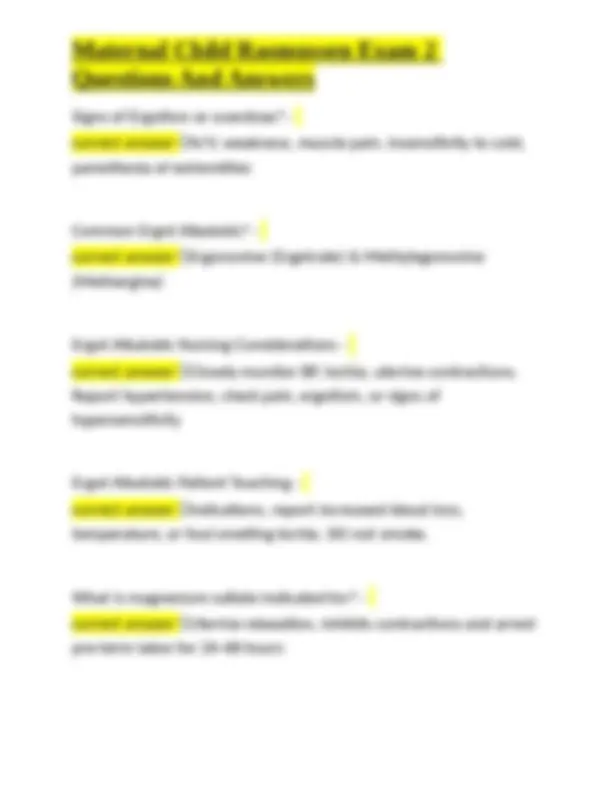
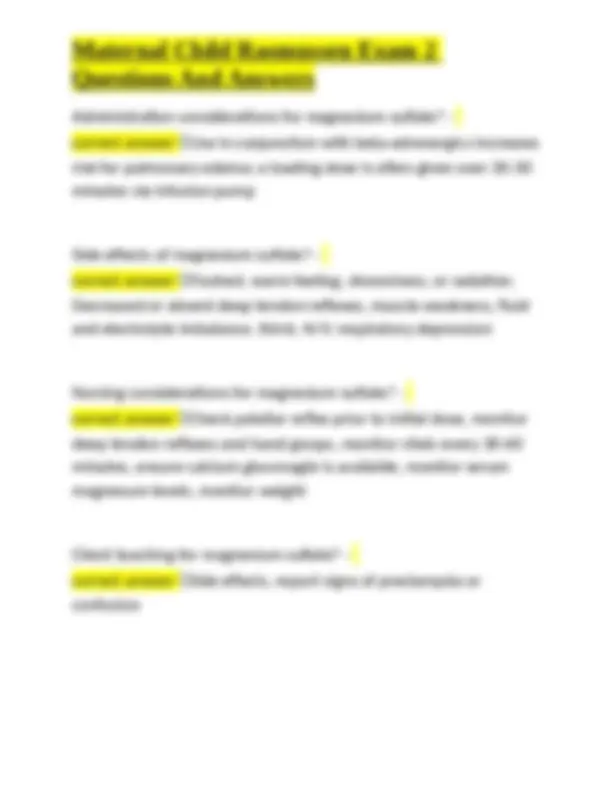
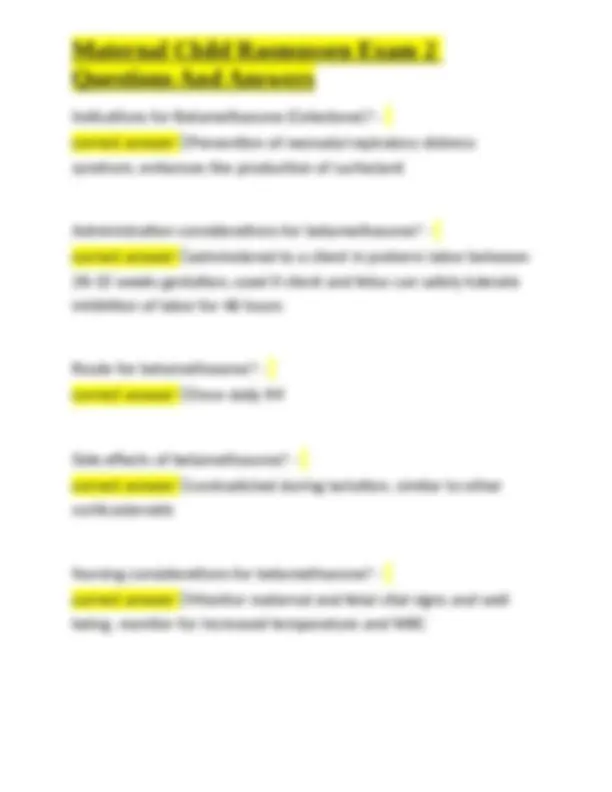
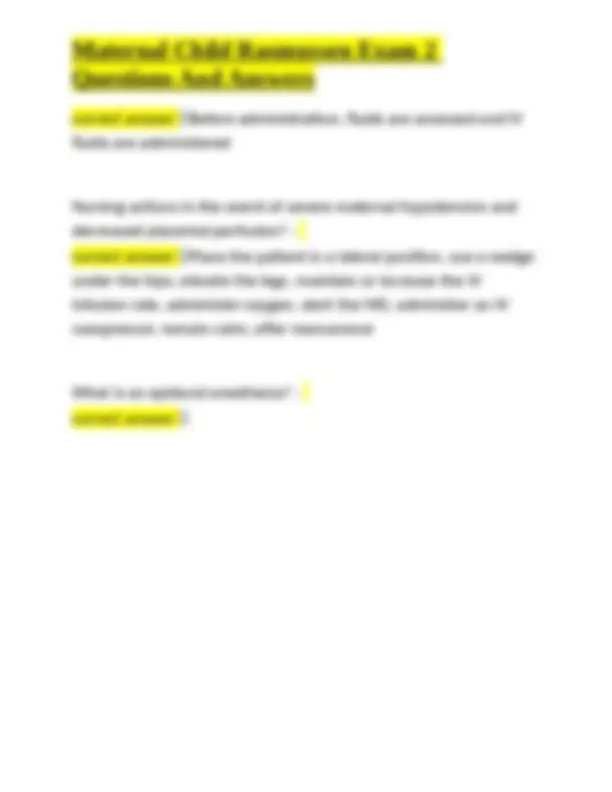


Study with the several resources on Docsity

Earn points by helping other students or get them with a premium plan


Prepare for your exams
Study with the several resources on Docsity

Earn points to download
Earn points by helping other students or get them with a premium plan
Community
Ask the community for help and clear up your study doubts
Discover the best universities in your country according to Docsity users
Free resources
Download our free guides on studying techniques, anxiety management strategies, and thesis advice from Docsity tutors
Maternal Child Rasmussen Exam 2 Questions And Answers
Typology: Exams
1 / 13

This page cannot be seen from the preview
Don't miss anything!








First stage of labor signs - correct answer ✅Begins with the onset of regular uterine contraction and ends with the complete dilation of cervix Which stage of labor is the longest (typically)? - correct answer ✅The first What are the 3 phases of the first stage of labor? - correct answer ✅Latent, active, and transition Describe the latent stage of labor - correct answer ✅Begins with the establishment of regular contractions. Contractions are typically about 5 minutes apart and last 30-45 seconds. They tend to be mild. Mother is chatty and sociable. Cervical effacement and early dilation (0-3 cm) occurs. Can last 10-14 hours. Describe the active phase of labor - correct answer ✅Characterized by more active contractions (every 3-5 minutes and last around 60 seconds) that are of a moderate to strong intensity. The mother becomes more focused on each
contraction. Cervical dilation advances more quickly (1 cm per hour) Describe the transition phase of labor - correct answer ✅Contractions are every 2-3 minutes that last 60- seconds. Mother may feel like she can't continue; she may feel more rectal pressure and the urge to push. Increase in bloody show. What phase of labor is the most intense? - correct answer ✅Latent Nursing role during the first stage of labor? - correct answer ✅Support (presence, spirituality, promotion of comfort, etc), assessment of fetus, assessment of mother, care for birth partner, and anticipatory care. What is the second stage of labor? - correct answer ✅Commences with full dilation of the cervix and ends with the birth of the infant. Contractions remain similar to the transitional phase.
Vaginal examinations during labor? - correct answer ✅Preformed digitally by the provider or nurse to assess for cervical dilation, decent of the fetus, fetal positioning, and whether membranes are intact or ruptured. Pain medications available for laboring mothers? - correct answer ✅Sedatives, antimetics, barbituates, benzodiazepines, and H1 receptor agonists. Sedative use in labor? - correct answer ✅Used in the first stage of labor to induce sleep and relieve pain; should not be given in active labor due to the risk of fetal respiratory depression Most commonly used barbituate in labor? - correct answer ✅Secobarbital sodium (Seconal) Why are barbituates rarely used during labor? - correct answer ✅Undesirable effects: maternal and neonatal respiratory and vasomotor depression (intesified when used
concurrently with another CNS depressant), and because if not given with an analgesic it will increase pain Why are benzodiazepines used in labor? - correct answer ✅Primarily to treat anxiety What are H1-Receptor agonists? - correct answer ✅Medications that block the action of histamines at the receptor sites that produce sedative, antiemetic effects. Used in early labor to promote sleep and reduce anxiety What are some H1-Receptor agonists used in labor? - correct answer ✅Promethazine (Phenergan), Hydroxyzine (Vistaril), Diphenhydramine (Benadryl) Types of analgesia avaliable in the first stage of labor? - correct answer ✅Opioid agonists, opioid agonist-antagonists, epidural, and combined spinal-epidural
Oxytocin (Pitocin) Nursing considerations? - correct answer ✅Record maternal vitals, weight, I&O, contractions, and fetal HR/tones q15m. Monitor for hypertonic contractions. Effects will diminish 2-3 minutes after discontinuation. Watch for hypertensive crisis. What are the Ergot Alkaloids used for? - correct answer ✅To control postpartum hemorrhage; should not be used prior to delivery of placenta. Cause clonic contractions of the uterus, arterial vasoconstriction, and possible vasospasm Administration considerations of Ergot Alkaloids? - correct answer ✅Causes rebound uterine relaxation Side effects of Ergot Aldaloids? - correct answer ✅Should be used cautiously in unstable angina/recent MI. Uterine cramping, increase in BP, cardiac dysrhythmias, and decreased milk production
Signs of Ergotism or overdose? - correct answer ✅N/V, weakness, muscle pain, insensitivity to cold, paresthesia of extremities Common Ergot Alkaloids? - correct answer ✅Ergonovine (Ergotrate) & Methylegonovine (Methergine) Ergot Alkaloids Nursing Considerations - correct answer ✅Closely monitor BP, lochia, uterine contractions. Report hypertension, chest pain, ergotism, or signs of hypersensitivity Ergot Alkaloids Patient Teaching - correct answer ✅Indications, report increased blood loss, temperature, or foul smelling lochia. DO not smoke. What is magnesium sulfate indicated for? - correct answer ✅Uterine relaxation, inhibits contractions and arrest pre-term labor for 24-48 hours
Indications for Betamethasone (Celestone)? - correct answer ✅Prevention of neonatal repiratory distress syndrom, enhances the production of surfactant Administration considerations for betamethasone? - correct answer ✅adminstered to a client in preterm labor between 28-32 weeks gestation; used if client and fetus can safely tolerate inhibition of labor for 48 hours Route for betamethasone? - correct answer ✅Once daily IM Side effects of betamethasone? - correct answer ✅contradicted during lactation, similar to other corticosteroids Nursing considerations for betamethasone? - correct answer ✅Monitor maternal and fetal vital signs and well being, monitor for increased temperature and WBC
What is regional anesthesia? - correct answer ✅Temporary and reversible loss of sensation produced by the injection of an anesthetic agent Nursing actions for regional anesthesia? - correct answer ✅Ensure epinephrine, antihistamines, and oxygen are readily available What is a pundal nerve block? - correct answer ✅Provides pain relief in the lower vagina, vulva, and periueum; should be adminstered 10-20 minutes before perineal anesthesia and may be used in the second stage of labor. Diminishes the maternal bearing down reflex What is a spinal anesthesia block? - correct answer ✅The injection of a solution containing a single local anesthetic through the 3rd, 4th, or 5th lumbar space into the cerebrospinal fluid Affected areas in the spinal anesthesia block? - correct answer ✅uterus, cervix, vagina, and perineum
correct answer ✅Before administration, fluids are assessed and IV fluids are administered Nursing actions in the event of severe maternal hypotension and decreased placental perfusion? - correct answer ✅Place the patient in a lateral position, use a wedge under the hips, elevate the legs, maintain or increase the IV infusion rate, administer oxygen, alert the MD, administer an IV vasopressor, remain calm, offer reassurance What is an epidural anesthesia? - correct answer ✅